What Is the Spiritual Meaning of the Butterfly Symbol?
The butterfly is a potent symbol of transformation and metamorphosis, representing human growth and self-realization. Its metamorphic life cycle is often associated with themes of rebirth and new beginnings.
With its free and independent flight, the butterfly also embodies personal liberty and the journey toward self-actualization. In spiritual traditions, it signifies the soul's evolution and eternal existence.
Cultural interpretations are diverse, spanning from Greek mythology to Japanese lore, where it conveys joy and longevity. Additionally, in the context of love, the butterfly's life stages mirror relational development.
To fully grasp its multifaceted symbolism, further exploration reveals deeper cultural and contextual nuances.
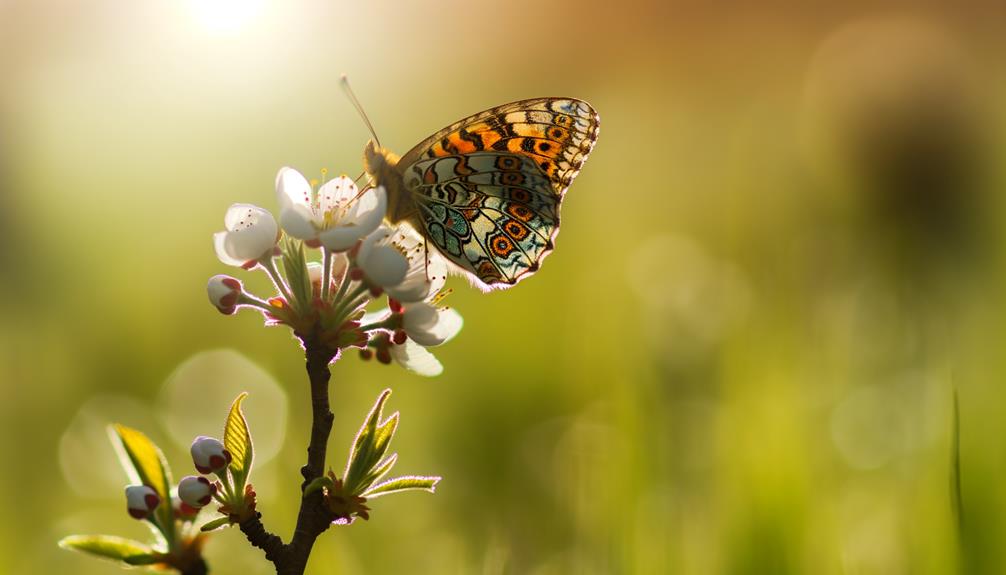
Key Takeaways
- Butterfly symbolizes transformation and metamorphosis, reflecting personal growth and self-realization.
- It represents freedom and independence, embodying unbounded potential and self-determination.
- In spiritual and religious contexts, the butterfly symbolizes rebirth, the soul, and spiritual evolution.
- Different cultures interpret butterflies as symbols of the soul, joy, longevity, and change.
- In love and relationships, butterflies symbolize stages of relational development and the beauty of emotional growth.
Transformation and Metamorphosis
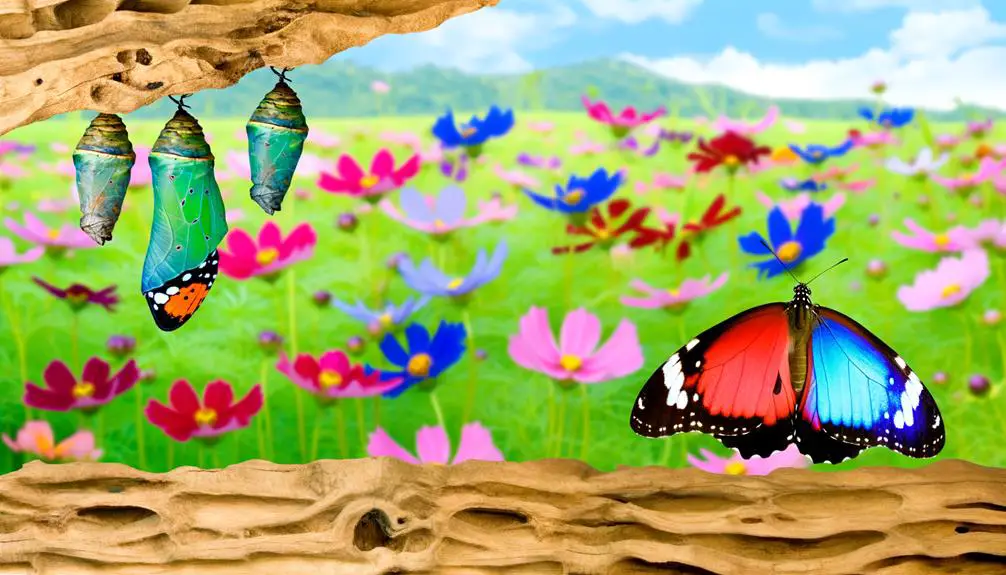
The symbol of a butterfly is profoundly emblematic of transformation and metamorphosis, representing a journey of profound change and evolution from one state of being to another.
This metamorphosis, observable in the butterfly's life cycle – from caterpillar to chrysalis and finally to its winged form – mirrors the human experience of growth and self-realization.
The transformation process encapsulates significant themes such as rebirth and renewal, shedding old identities to embrace new, elevated forms. It serves as a powerful metaphor in various cultural, spiritual, and psychological contexts, illustrating the potential for change inherent in all living beings.
This symbol resonates deeply in narratives of personal development, offering a vivid illustration of the arduous yet rewarding path of transformation.
Freedom and Independence
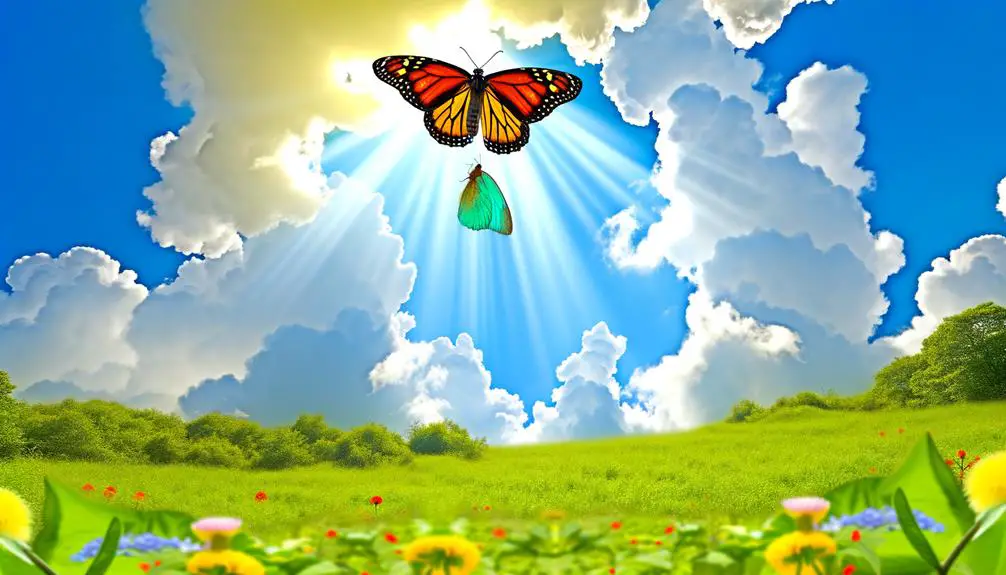
Frequently symbolizing freedom and independence, the butterfly's ability to traverse vast distances with effortless grace embodies the essence of unbounded potential and self-governance. This symbolic representation stems from the butterfly's life cycle, wherein it emerges from the restrictive cocoon into an expansive world, unfettered and autonomous.
The butterfly's flight, characterized by both spontaneity and purpose, mirrors the human aspiration for personal liberty and self-determination. In various cultures, the butterfly is revered as an emblem of emancipation, reflecting a journey towards self-actualization and the breaking free from societal constraints.
Spiritual and Religious Significance
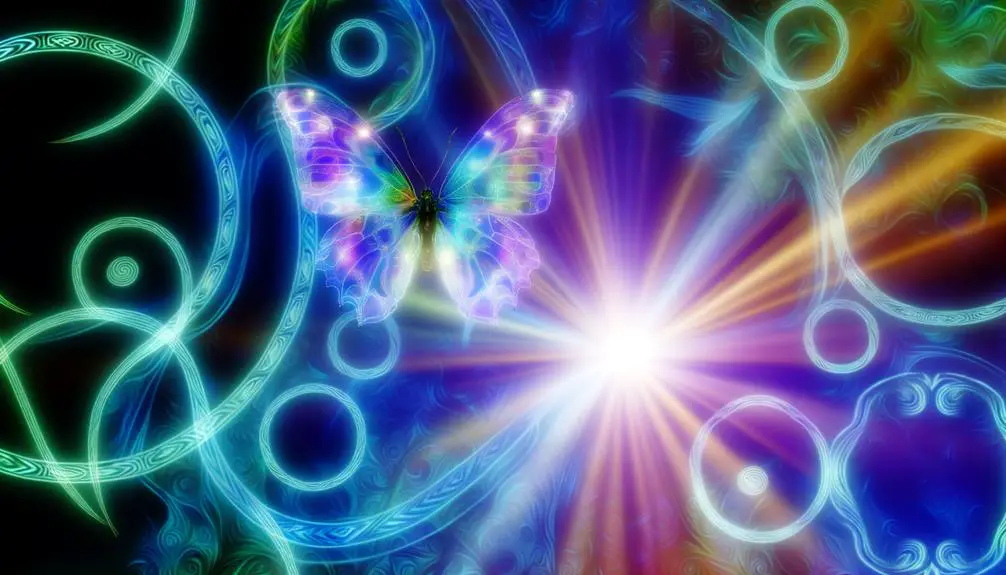
In numerous spiritual and religious traditions, the butterfly is emblematic of profound themes such as transformation and rebirth, reflecting its metamorphic life cycle.
Additionally, it is often associated with the soul and the afterlife, symbolizing the journey of the spirit beyond the physical domain.
These aspects underscore the butterfly's role as a powerful icon in conveying concepts of spiritual evolution and eternal existence.
Transformation and Rebirth
Often regarded as a profound emblem, the butterfly symbolizes transformation and rebirth across various spiritual and religious traditions.
In many cultures, the metamorphosis from caterpillar to butterfly is viewed as a powerful metaphor for personal growth and spiritual awakening.
For instance, in Christianity, the butterfly represents the resurrection of Christ and the promise of new life.
Similarly, in Eastern philosophies such as Buddhism, the butterfly's journey signifies enlightenment and the cyclical nature of existence.
Indigenous tribes, too, revere butterflies as messengers of change and renewal, often integrating their imagery into rituals and folklore.
This universal symbolism underscores a collective human aspiration for transcendence, embodying the dynamic process of shedding old selves to embrace new, enlightened identities.
Soul and Afterlife
Beyond its association with transformation and rebirth, the butterfly also holds profound significance as a symbol of the soul and afterlife in numerous spiritual and religious contexts.
In ancient Greek culture, the butterfly was emblematic of the psyche, representing the human soul. Similarly, in various Native American traditions, butterflies are seen as messengers from the spirit world.
In Christianity, the metamorphosis of the butterfly is often interpreted as a symbol of resurrection and eternal life. The ephemeral beauty and delicate nature of butterflies have led many spiritual traditions to view them as tangible connections to the divine, embodying the transcendence of the soul beyond the mortal plane.
This multifaceted symbolism underscores the butterfly's enduring spiritual resonance across cultures.
Cultural Interpretations
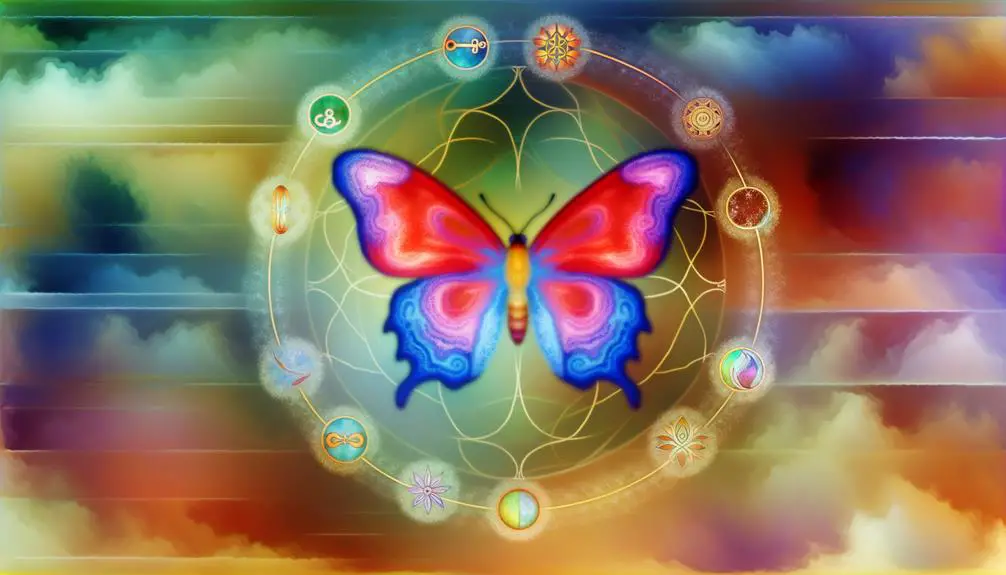
Exploring the cultural interpretations of the butterfly symbol reveals a rich tapestry of meanings that vary greatly across different societies and historical contexts.
In ancient Greek mythology, the butterfly represents the human soul, with Psyche, the goddess of the soul, often depicted with butterfly wings.
In Japanese culture, butterflies are symbols of joy and longevity, embodying the spirits of the departed.
Indigenous tribes of North America imbue butterflies with transformative power, seeing them as messengers of change and rebirth.
Consider the following evocative cultural associations of the butterfly symbol:
- Greek Mythology: The butterfly as the soul's metamorphosis.
- Japanese Tradition: Butterflies as emblems of happiness and long life.
- Native American Beliefs: Butterflies as harbingers of transformation and renewal.
This cultural multiplicity underscores the butterfly's profound global resonance.
Love and Relationships
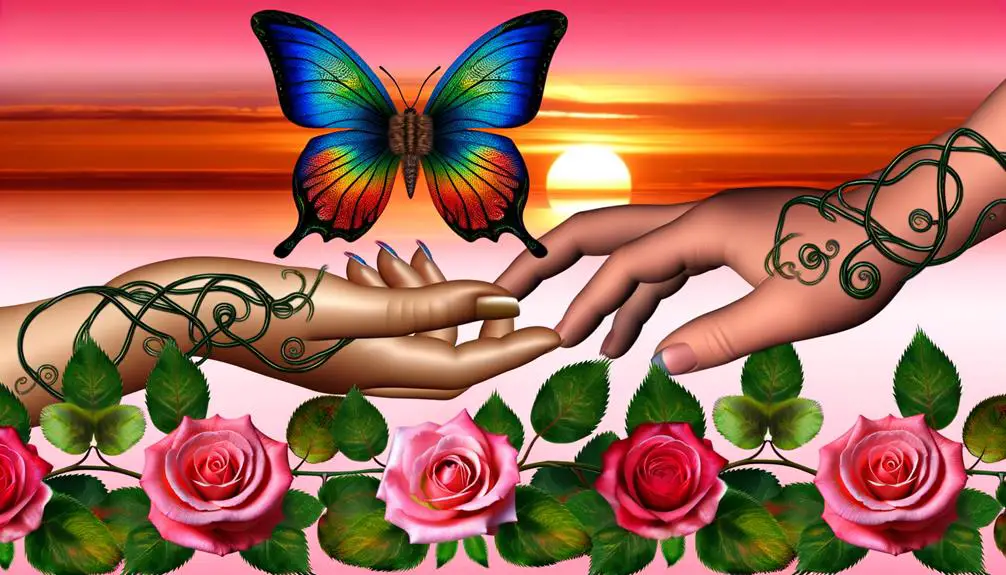
In the domain of love and relationships, the butterfly emerges as a potent symbol of transformation, reflecting the profound changes and growth that romantic connections often inspire. This metamorphic insect encapsulates the journey from initial attraction to deep emotional bonding, mirroring the stages of relational development.
The butterfly's lifecycle—from caterpillar to chrysalis to adult—parallels how individuals and relationships evolve, often necessitating periods of introspection and adaptation. Its delicate yet resilient nature underscores the balance between vulnerability and strength essential for enduring partnerships.
Moreover, the butterfly's vibrant colors symbolize the joy and beauty that love can bring, emphasizing that true connection requires both partners to embrace change and flourish together.
Hope and Renewal
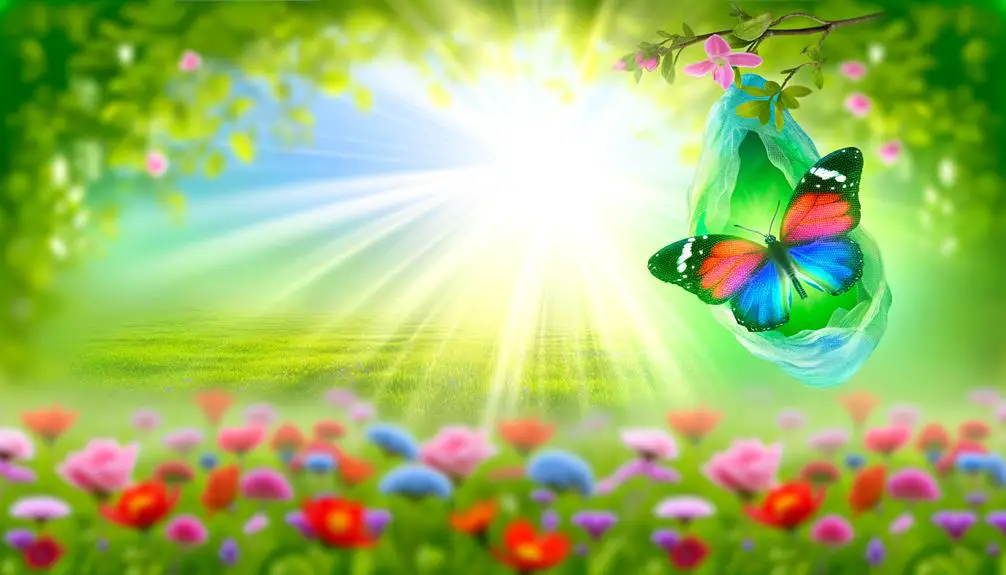
The butterfly, with its remarkable journey from a grounded caterpillar to a soaring, vibrant creature, serves as an enduring symbol of hope and renewal, illustrating the profound potential for rebirth and positive transformation in the face of adversity.
This metamorphosis, grounded in the natural world, resonates deeply with human experiences of overcoming obstacles and emerging stronger.
Consider the following evocative elements:
- Resilience: The caterpillar's struggle through the cocoon mirrors our own battles and triumphs.
- Growth: The transformation symbolizes personal development and the pursuit of betterment.
- New Beginnings: The emergence of the butterfly epitomizes fresh starts, inspiring optimism and courage.
This symbolism underscores the universal human capacity for renewal, signifying that even in life's darkest moments, hope and transformation are possible.
Artistic and Literary Symbolism
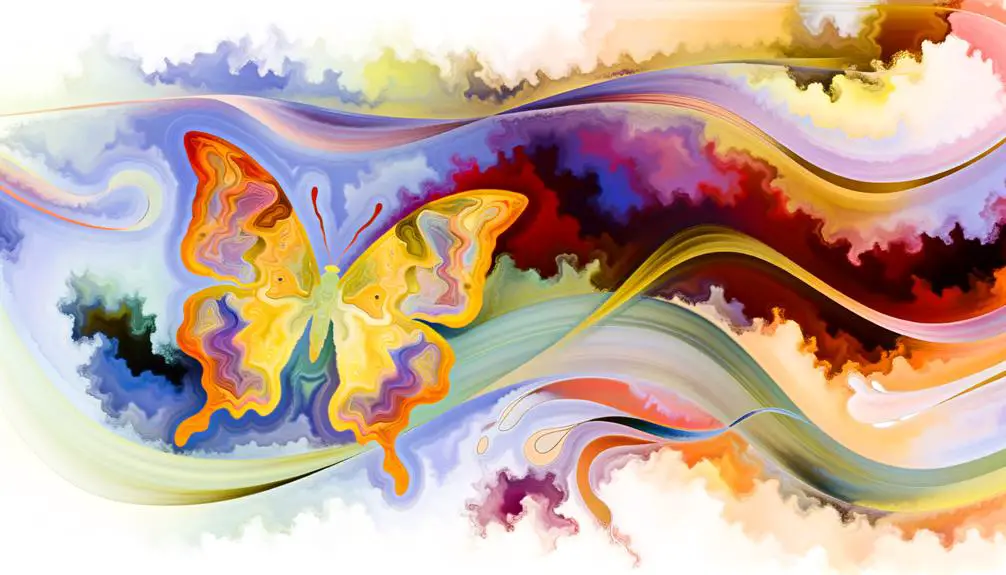
In both artistic and literary contexts, the butterfly often symbolizes profound transformation, mirroring the process of metamorphosis. This imagery is harnessed to explore themes of personal growth, transcendence, and the ephemeral nature of beauty and life.
Literary motifs frequently employ the butterfly to signify characters' evolutions or the cyclical patterns of existence, enriching the narrative with layers of symbolic meaning.
Metamorphosis in Art
Artists and writers have long utilized the butterfly's metamorphosis as a profound metaphor for transformation, symbolizing themes of rebirth, renewal, and the transcendence of the human spirit.
In art, this metamorphosis is depicted through various mediums, each capturing the delicate yet powerful essence of change. The butterfly's journey from caterpillar to chrysalis to ethereal being resonates deeply, providing a visual allegory for personal and societal transformation.
Consider these evocative elements:
- Emergence from the chrysalis: Represents breaking free from constraints.
- Vibrant wings: Symbolizes newfound freedom and potential.
- Ephemeral beauty: Highlights the fleeting nature of life and moments of transcendence.
Such depictions in art invite viewers to reflect on their own paths of growth and renewal.
Literary Motifs
Literary works, much like visual art, frequently employ the butterfly as a potent symbol of transformation, freedom, and the ephemeral nature of existence. This motif is prevalent in various literary traditions, from ancient texts to contemporary narratives.
In classical literature, the butterfly often represents the soul, as seen in Greek mythology where Psyche—embodying the human soul—is depicted with butterfly wings. Modern literature extends this symbolism, frequently using the butterfly to explore themes of personal growth and the fleeting nature of life.
In Nabokov's 'Lolita,' butterflies are intricately linked to the protagonist's obsession and the transient beauty he pursues. Therefore, the butterfly remains a versatile and enduring symbol, rich in interpretative potential across literary landscapes.
Conclusion
The butterfly, emblematic of transformation and metamorphosis, serves as a poignant reminder that change is an intrinsic part of life. Its symbolism extends across various dimensions, encompassing freedom, spiritual significance, and cultural interpretations.
In the domain of love and relationships, it signifies growth and renewal. As the adage goes, 'Change is the only constant,' and the butterfly encapsulates this truth, resonating deeply within artistic and literary contexts as a symbol of hope and enduring beauty.






